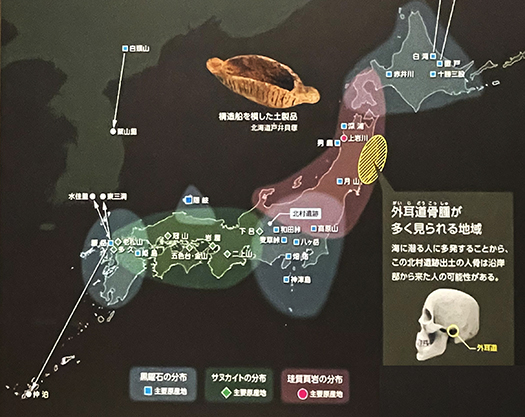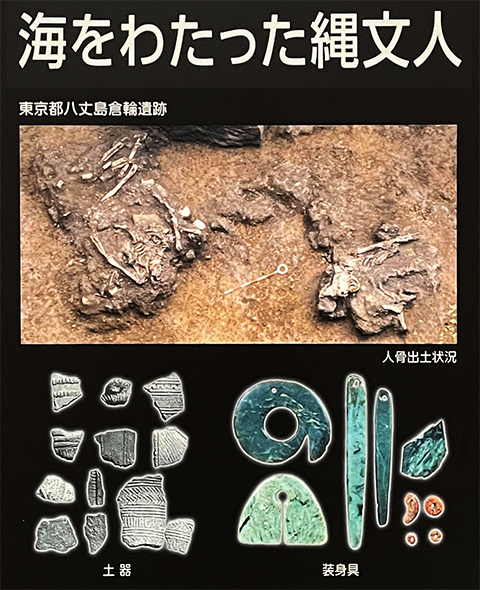


旧石器時代の「移動・遊動」というライフスタイルから縄文定住に移行すると
人間活動はより地域的範囲に留まるのかと錯覚するけれど、
むしろ広域範囲間での移動の拡大・交易発展の実相が浮かんでくる。
上の図は日本列島各地域間のネットワークを図示。
北海道白滝の黒曜石はサハリンやアムール川河口域と交易されたし
同時に青森県深浦・秋田県男鹿・山形県月山地域でも発掘される。
伊豆沖合の神津島出土の黒曜石は、本州中部の和田峠など
関東から本州中部地域で発見されてきている。
八丈島の倉輪遺跡や島嶼部の遺跡からは、本州の遺跡と深く関わる
土器・装身具などが出土していて日常的に「海を渡っていた」ことがわかる。
旧石器の頃には狩猟採集の範囲に留まっていた移動が活発に拡大し
定期的交易の発展ぶりがさながら現代人の出張移動にも似てくる。
現代では飛行機での移動であるものが、海流を見計らった丸木舟移動。
手段は違えど、目的性に於いてはまったく同様だと思える。
さらに「外から来た人びと」というパネルではムラ間の移住痕跡も。
〜人の体内には微量のストロンチウム同位体が存在する。これは主に
食物によって体内に取り込まれ、永久歯には「生まれ育った」土地の痕跡が
固定されるのだという。そこからムラ内部で「移住者」を判別できる。〜
表を見ると男女とも3割以上程度の割合で見ることができる。
この割合というのは現代と比較しても大差ないのではないか。
移住の経緯はたぶん結婚が主要な要因ではないかと想像できる。
ムラ集落内部だけの婚姻ではやがて遺伝的困難を引き起こすという
DNAレベルでの「知恵」が働いて、やや離れた地域間での婚姻が
通常化した、というように見なしうるだろう。
余談だけれどわたしの父は、交易活動を幅広く行って
やや遠隔の地域に出張活動してそこで母に「ひとめぼれ」したという(笑)。
昭和の時代に起こったことが、縄文の世でも普遍的にあったと思える。

このような活発な「交易」による相互発展はさらに目的的な
地域発展経済動機を生んでいく流れになることは理の当然。
旧石器以来の産業基盤ともいえる黒曜石などの希少石材を求めて
地下資源を探索したり、さらに進んで「特産品」制作にも発展した。
ヒスイ製品や磨製石斧、貝輪や干し貝、塩、アスファルトなどを生産した。
お互いの社会が豊かに発展するための相互交流手段として
経済が基本に据えられて同時に婚姻などにも繋がっていく。
地域間交流ということが遺伝的安全をも保障して人間社会を発展させていった。
縄文の1万年を超える営為の中で日本社会の原型が作られていった。
ひとつひとつの事象の科学的解析が大いに進んで、
人間社会発展の具体的なイメージが膨らんでくる。・・・
English version⬇
Trade Guarantees Economic and Genetic Security: The 37,000-Year History of the Japanese Islands – 22
Exchange and trade ensured the mutual development of village societies, and at the same time, increased human interaction induced intermarriage and guaranteed genetic security. The exchange and trade guaranteed the mutual development of village societies.
The shift from the Paleolithic lifestyle of “movement and mobility” to Jomon settlement gives the illusion that human activities are more localized.
one would think that human activities would have remained within a more localized area.
The figure above illustrates the network between the various regions of the Japanese archipelago.
The figure above illustrates the network among the regions of the Japanese archipelago.
Obsidian from Shirataki, Hokkaido, was traded with Sakhalin and the Amur River estuary.
At the same time, obsidian was excavated in Fukaura, Aomori Prefecture; Oga, Akita Prefecture; and Tsukiyama, Yamagata Prefecture.
Obsidian excavated from Kozushima Island, off the coast of Izu, is found in the Wadatoge area in central Honshu.
It has been discovered in the Kanto to central Honshu area.
The Kurawa site on Hachijojima and other sites on the islands are deeply related to those on Honshu.
The excavation of earthenware and accessories at the Kurawa site on Hachijojima and other sites on the islands indicate that the people “crossed the sea” on a daily basis.
In the Paleolithic period, migration was limited to hunting and gathering, but it is now actively expanding, and the development of regular trade is evident.
The development of regular trade resembles the business travel of modern humans.
What is done by airplanes in the modern age is done by marines traveling by wooden boats that follow the currents of the sea.
Although the means of travel is different, the purpose of travel seems to be exactly the same.
In addition, the panel “People from Outside” also shows traces of migration between villages.
〜The panel also showed traces of inter-mural migration. This is mainly
isotopes are taken into the body mainly by food, and the traces of the “native” land are fixed in the permanent teeth.
The permanent teeth are fixed with traces of the land where they were “born and raised”. From there, it is possible to identify “migrants” inside the mura. ~.
The table shows that more than 30% of both men and women can be seen.
This percentage is not much different from that of today.
We can imagine that marriage is probably the main reason for migration.
The “wisdom” at the DNA level tells us that intermarriage only within the Mula community will eventually cause genetic difficulties.
DNA-level “wisdom” that intermarriage only within a mura village would eventually cause genetic difficulties.
This may be seen as a “wisdom” at the DNA level that intermarriage only within a mura community would eventually cause genetic difficulties.
As a side note, my father was a trader who traveled extensively to
He traveled to a somewhat remote area and fell in love with my mother there (laugh).
What happened in the Showa era seems to have been universal in the Jomon era.
Mutual development through such active “trade” will further create a flow of purposeful
It is only natural that the mutual development through such active “trade” would give birth to more purposeful economic motives for regional development.
The search for rare stones such as obsidian, which has been the foundation of industry since the Paleolithic period, led to the search for underground resources and the creation of “local products.
The search for underground resources for rare stones such as obsidian, which has been the foundation of industry since the Paleolithic period, and the production of “local specialties” developed further.
They produced jade products, polished stone axes, shell rings, dried shells, salt, asphalt, etc.
As a means of mutual exchange for the enrichment and development of each other’s societies
The economy became the basic means of interaction for the development and enrichment of each other’s societies, and this led to intermarriage and other forms of interchange.
Interregional exchange also ensured genetic security and promoted the development of human society.
The prototype of Japanese society was created during the Jomon period of more than 10,000 years of activity.
Scientific analysis of each event has progressed greatly, and a concrete image of the development of human society has expanded.
The more scientific analysis of each event, the more concrete the image of the development of human society will become. The development of human society is now in the process of being realized.
Posted on 11月 22nd, 2022 by 三木 奎吾
Filed under: 日本社会・文化研究, 歴史探訪







コメントを投稿
「※誹謗中傷や、悪意のある書き込み、営利目的などのコメントを防ぐために、投稿された全てのコメントは一時的に保留されますのでご了承ください。」
You must be logged in to post a comment.